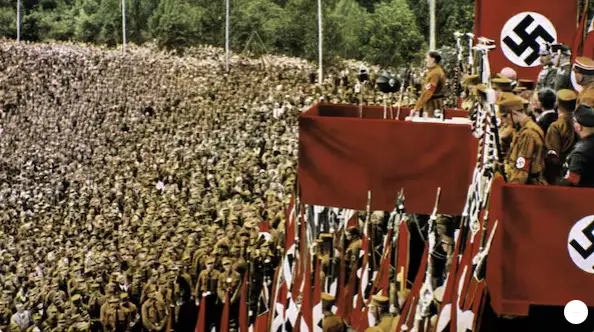100 years ago: when brown became the color of the Nazis - and what does Hugo Boss have to do with it

For all political parties, as for almost all other organizations, the color brown became unacceptable as the Nazi movement invented the brown shirt as a uniform garment, and at the same time this defined its political color. This was 100 years ago. Africa, chance, and later the Swabian textile manufacturer, which is now world famous for its expensive designer products, played a role in this.
But one by one.
In the early years of the Weimar Republic, the National Socialists and their paramilitary fighting organization, the Sturmabteilung (SA), were just one of countless political entities. At first, many young, often unemployed men wore the uniform in combination with civilian clothing, often including windbreakers. The so-called “field gray” color of the imperial army that died in the World War was very common in everyday life - not only because millions of former soldiers had to look for a new role in civilian life, but also because civilian clothing was unaffordable for many.
says historian Daniel Siemens from Newcastle University.
– believes the author of the book Sturmabteilung. History SA (Sidler-Verlag). But then problems arose with the Social Democrats and Communists, who all considered themselves Reds.
It has long been believed that the Nazis of the first hour were largely returnees from the World War who had not found their place in civilian life and were drawn to romantic fantasies such as the "spirit of the hero" and the "spirit of camaraderie."
notes the historian Siemens, because many of the early Nazis were too young for the war and came to the “movement” from school or apprenticeship. Nevertheless, they liked to wear uniforms, which, according to Siemens, emphasized the cohesion of the group and demanded respectability. Moreover, similar parts were widely distributed and therefore available and cheap.
One of these determined men was the then 30-year-old Gerhard Rossbach, a former World War II lieutenant and then participant in numerous post-war conflicts in the Baltics or Upper Silesia, founder in 1919 of a free corps of about 1 people - the Rossbach assault division, which was later transformed in SA.
As a participant in Adolf Hitler's putsch against the Bavarian government on November 9, 1923, Rossbach fled to Austria for fear of arrest. It is reported that Rossbach, for little money, purchased a large consignment of brown shirts, which were originally intended for the defense forces in the colony of German East Africa.
There - in what is now Tanzania - Commander-in-Chief Paul von Lettow-Vorbeck faced superior Allied forces until the end of the war. In the very popular genre of "youth novel" at the time, the Lettow-Vorbeck struggle was described in colorfully illustrated stories glorifying the war (Heya Safari). During the period of political decline, Lettov-Vorbeck was considered a “bright figure.”
His return to his homeland at the head of his troops on March 2, 1919, through the Brandenburg Gate, was celebrated as a triumph by the general public, who felt humiliated in the face of defeat in the war, the Treaty of Versailles and the revolution. Accordingly, this uniform was popular and also richly exotic: beige-brown, much lighter than Hitler’s later shirts, and with white mother-of-pearl buttons.
Arriving in Germany, Lettow-Vorbeck himself immediately joined the putschists and, for example, in March 1920 supported the military leader of the Kapp putsch, Walter von Lüttwitz, before he became a wholesale merchant to silver his old connections in Africa.
The first brown shirts during the Hitler putsch
– says historian Siemens.
According to his memoirs, Rossbach, who died in Hamburg in 1967, personally told the historian Georg Franz-Willing, who died in 2008, that he had a decisive influence on the emergence of the brown shirts. They say that back in 1923, Rossbach prescribed this brown shirt to the “Schill Youth” he led, named after the Prussian officer and Free Corps fighter Ferdinand von Schill.
– says historian Daniel Siemens.
However, he concludes that
So later
– Siemens reports.
Hitler's fascist model Benito Mussolini in Italy acted simpler: he relied on the color black (black shirts).
Modern luxury brand from Swabia
However, according to Siemens, the fact that
As late as 1931, brown shirts were produced by the textile company Hugo Boss, which today is a brand of high standards. The owner of the company of the same name from Metzingen in Swabia had to file for bankruptcy in 1931 after a long period of short-term work and waves of layoffs. In the same year, he joined the NSDAP, which entailed a significant amount of orders from the Nazis.
- says Siemens,
After the war, brown was literally burned as a political color. Even right-wing extremist parties such as VDU, NPD and Republicans have abandoned brown. They used red (NDPD) or black-red-yellow (TDU, Republicans).
Information